Rivers,
Lakes, Springs, Tributaries and Glaciers
Jammu
and Kashmir State is well known for its charming
scenery. There are beautiful springs, lakes,
rivers and their tributaries. All these add to its
scenic beauty.
The
Jhelum (Vyeth in Kashmiri, Vetesta
in Sanskrit and Hydaspes in Greek) is the
main waterway of the valley of Kashmir. It rises
from a beautiful spring called Verinag. This
spring is situated at the foot of a spur of the
Pir Panjal mountain.
The
Jhelum flows to a distance of 25.6 Kms to Khanabal
like a nullah. From that place a number of
tributaries join the Jhelum and make it navigable
from Khannabal to WullarLake. Its total length in
the valley is 177 kms. It flows in loops through
the valley till it enters the Wullar; it flows out
from its other side to Baramulla and then it
enters the boundary of Pakistan. This part is not
navigable, as the river makes a very deep bed and
acquires a swift flow.
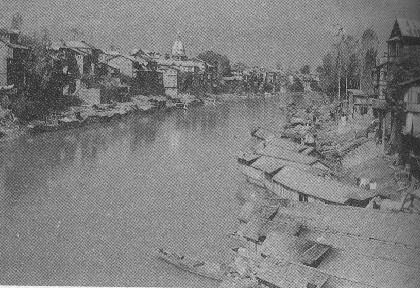
The
river Jhelum.
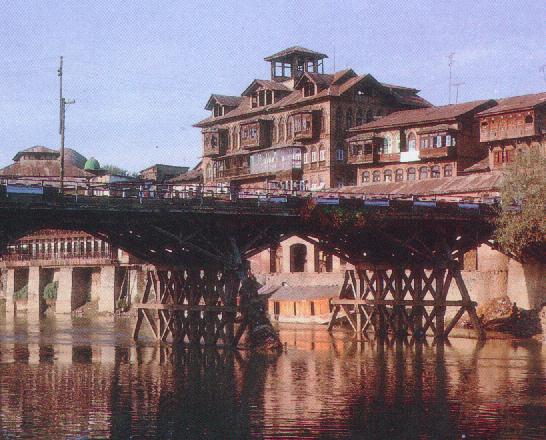
One
of the bridges that span the Jhelum in the old
city.
Srinagar
town is situated on the either side of the river
Jhelum. This enhances the beauty of the town
making it a source of attraction for the tourists
who stay in house-boats staying permanently in
water on the banks of the river.
Tributaries
of the river Jhelum
1.
The Vishav is fed by lhe Kaunsarnag lake
which is about 3 Kms long. It joins theJhelum
below Bijbehara. Kounsarnag is at an elevation of
about 4000 metres above sea level in the Panjal
mountains to the south of Kashmir. Ice is present
in the lake even in summer.
The
Vishav irrigates the Kulgam Tehsil and logs of
timber cut in the forests in its upper course are
floated down it to be transported to the valley.
2.
The Romushi is another tributary of the
Jhelum. It flows from Kharmarg to Pakharpur and
flowing towards north-east. It joins the Jhelum at
75 deg. East longitude.
3
. The Dudhganga is another tributary of the
Jhelum that flows from Ludurmarg and rises in the
central Pir Panjal near Tata Kuti mountain. Two
mountain streams, the Sangesafed and the Yachera,
form this river. This river flows through Batmalu
Swamp near Srinagar.
4.
The Sukhang is another important tributary.
It rises near Gulmarg and irrigates a large area.
5.
The Lidar is one of the largest tributaries
of the Jhelum. It flows in a swift narrow stream
from Sheeshnag lake to the east of Pahalgam. The
Lidar passes through many villages of which Mattan
(Martand) is very famous. The Kolahai and
Sheeshnag streamlets join the Lidar at Pahalgam to
make it a river.
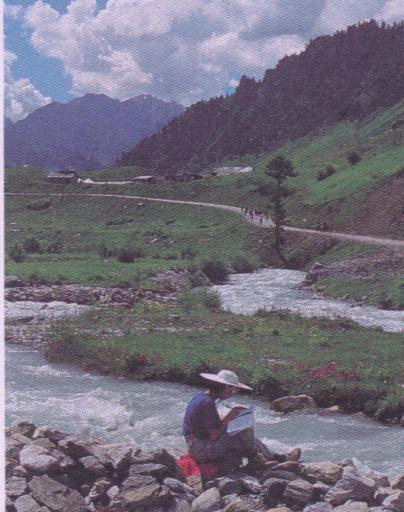
Lidar
at Pahalgam.
6.
The Ferozpore Nullah is an important
water-way in the western mountains of
Baramulla-Gulmarg area. It collects water from
many mountain streams, small lakes and springs.
This mountaineous area is mostly full of snow even
in summer.
7.
The Sind Nullah has its source in the Inner
Himalayas at Dras and after it is fed by the
Gangabal lake lying at Harmukh mountain (5150
meters), it joins the Jhelum at Shadipur. It is 96
Kms in length. The famous health resorts of
Sonamarg and Ganderbal are situated on its banks.
Its water is used for irrigation purposes and the
'Sind Valley Hydroelectric Power Project' uses its
water at Gandarbal to produce electric power. It
is navigable from Gandarbal downwards.
8.
The Flood Spill Channel was constructed in
1904 to relieve the strain on the Jhelum in the
city of Srinagar. By taking 2/3rd of the total
flow in the river it helps the river Jhelum to
regulate its water level while passing through the
city of Srinagar. The Jhelum rises during floods
and the Channel saves the city from being flooded.
Lakes
1.
The Wullar Lake in Kashmir is the largest
fresh water lake in India. It is about 16 Kms.long
and 9 .6 Kms wide with ill-defined shores. This
lake lies between Bandipore and Sopore at a
distance of 75 Kms. from Srinagar. The Jhelum
enters this lake from the south-east and leaves it
from thewest. Storms rise in the lake everyday in
the afternoon. The deepest part of the lake is at
Watlab towards the hill called Baba Sukhuruddin in
the north-west. Many small streams, Harbuji, Aarah,
Erin and Pohru join this lake.
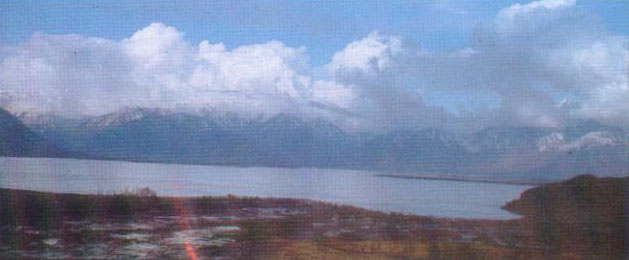
Wular
Lake.
2.
The Dal Lake is a beautiful lake near
Srinagar. It is 8 Kms long and 6.4 Kms. wide. It
is the flood-lung of the Jhelum. The famous Mughal
gardens are situated around it. The lake is an
ideal place for swimming and sailing in Shikaras
and motorboats. Floating gardens are found in this
lake where a large variety of vegetables is grown.
The The Dal lake has two parts, the small Dal and
the big Dal, separated by a swampy bund. The road
round the lake is called Boulevard. There are two
artificial islands in the lake, Rupalank and
Sonalank, built by Mughal Emperors. Nehru Park is
the western terminus of the lake. The lake is a
spot of great attraction for visitors, who enjoy
staying in house-boats in the lake.
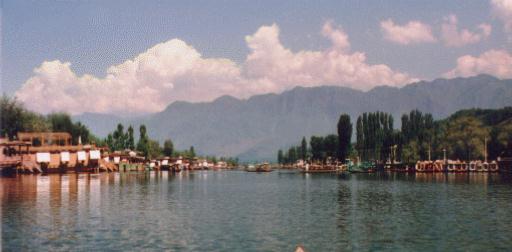
Dal
Lake.
3.
The Anchar Lake is a swampy area. The Sind
Nullah enters this lake from one side and flows
out from the other. It is about 8 Kms long and 3
Kms. wide. Gandarbal is a famous township on its
north-west bank.
4.
The Mansbal Lake is at a distance of 29 Kms.
from Srinagar and is situated at Safapore (Tehsil
Gandarbal). It is 5 Kms long and one Km. wide. It
is connected with the Jhelum by a canal near
Sumbal. Mughal Emperors have built a summer palace
on its bank.
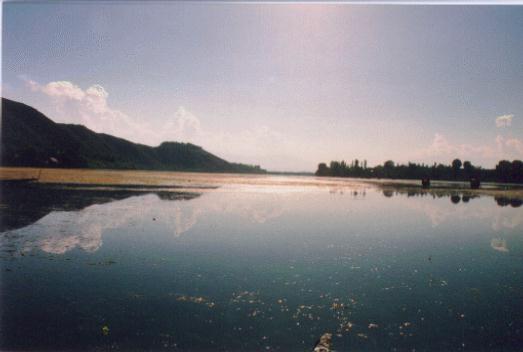
Manasbal
Lake.
5.
The Harvan Lake is situated at a distance
of 21 Kms from Srinagar. It is 278 meters long,
137 meters wide and 18 metres deep. This lake is a
source of water supply to Srinagar city.
6.
The Hokarsar Lake lies on Baramulla road
about 13 Kms. from Srinagar. It is about 5 Kms.
long and 1.5 Kms. wide. Willow trees are grown in
abundance around its banks.
7.
The Konsarnag or Vishno Pad Lake is
situated in the Pir Panjal range at a height of
4000 meters above sea level to the south of
Shopian. It is about 5 Kms. long and 3 Kms. wide
and is the source of the river Vishav. It is at a
distance of 34 Kms. from Shopian.
8.
The Gangabal Lake is situated at a height
of 3570.4M. on the peak of Harmukh mountain.
Hindus consider it a sacred lake.
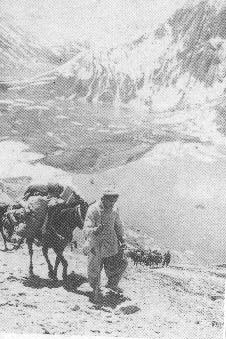
Gangabal
Lake.
9.
The Sheshnag Lake is situated near Vavjan,
enroute to Shri Amarnath cave. It is at a distance
of 28 Kms. from Pahalgam.
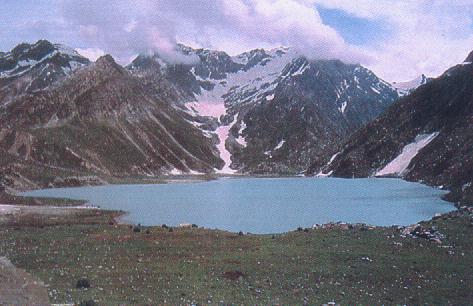
Sheshnag
Lake.
10.
The Neelang Lake is situated in Tehsil
Badgam at a distance of 10 Kms from Nagam. It is a
beautiful lake with dense forests around it.
11.
There are two more lakes, Tarsar and Marsar
that lie on the northern slope of the Harmukh
mountain. Marsar lake is the origin of the Canal
Sharab Kohl that provides water to the fountains
that play in the Mughal Gardens. Marsar lake flows
into the Lidar which is one of the largest
tributaries of the Jhelum.
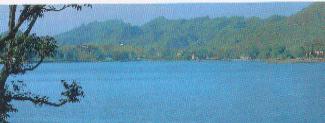
Mansar
Lake.
12.
Sokh and Dokh are two frozen lakes
situated at Harmukh Mountain. These are said to be
two tear drops of Parvati; one a warm tear drop
indicating happiness and other a cold one showing
grief.
Springs
Kashmir
valley abounds in numerous springs of which
Verinag (source of the Jhelum), Martand (Anantnag),
Achhabal (Anantnag), Kukarnag (Anantnag), Chashma
Shahi (famous for its fresh and digestive water,
situated near Srinagar on one side of the
Boulevard road), Tullamulla or Khirbhawani (a
sacred spring), Vicharnag, Sukhnag, Vishnosar and
Harmukat Ganga in Srinagar area and Chirnagand
Vasaknag in Anantnag are very famous.
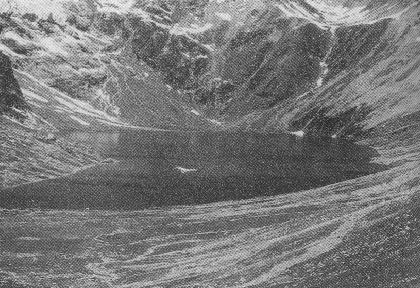
Vishnosar
Lake.
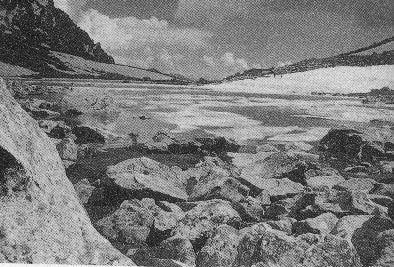
Gadsar
Lake.
|






















